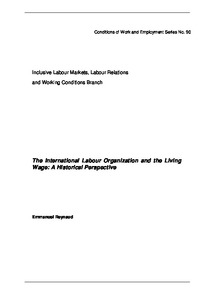The International Labour Organization and the living wage: a historical perspective
"The paper is structured in three parts. The first part reviews the process and the debates related to the adoption of the principle of a living wage at the 1919 Paris Peace Conference and when it was restated in Philadelphia in 1944. The two following parts deal with the implementation of the...
| Main Author: | |
|---|---|
| Institution: | ETUI-European Trade Union Institute |
| Format: | TEXT |
| Language: | English |
| Published: |
Geneva
2017
ILO |
| Subjects: | |
| Online Access: | https://www.labourline.org/KENTIKA-19287866124910050489-The-international-Labour-organ.htm |
| Summary: | "The paper is structured in three parts. The first part reviews the process and the debates related to the adoption of the principle of a living wage at the 1919 Paris Peace Conference and when it was restated in Philadelphia in 1944. The two following parts deal with the implementation of the principle. The second part reviews the initial work of the International Labour Office (the Office) and the debates among the ILO's constituents that led to the adoption of the Minimum Wage-Fixing Machinery Convention, 1928 (No. 26) and the corresponding Recommendation (No. 30). It also presents examples of countries which used the concept of a living wage in their legislation regarding minimum wage fixing. The third part reviews the renewed debates on minimum wages in the 1960s at the ILO Governing Body and at the International Labour Conference, which led to the adoption of the Minimum Wage Fixing Convention, 1970 (No. 131) and the corresponding Recommendation (No. 135)." |
|---|---|
| Physical Description: | 37 p. Digital |

